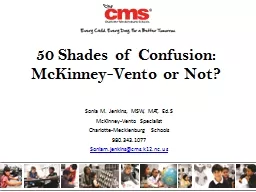

McKinneyVento Specialist CharlotteMecklenburg Schools 9803431077 Soniamjenkinscmsk12ncus 50 Shades of Confusion McKinneyVento or Not Purpose Focus on identifying homeless children and youth ID: 776359
Download Presentation The PPT/PDF document " Sonia M. Jenkins, MSW, MAT, Ed.S" is the property of its rightful owner. Permission is granted to download and print the materials on this web site for personal, non-commercial use only, and to display it on your personal computer provided you do not modify the materials and that you retain all copyright notices contained in the materials. By downloading content from our website, you accept the terms of this agreement.
Slide1
Sonia M. Jenkins, MSW, MAT, Ed.S
McKinney-Vento SpecialistCharlotte-Mecklenburg Schools980.343.1077Soniam.jenkins@cms.k12.nc.us
50 Shades of Confusion:
McKinney-Vento or Not?
Slide2Purpose
:
Focus on identifying homeless children and youth
Focus on complicated situations in relation to housing to determine McKinney-Vento eligibility
Learn assessment tools/questions to obtain all information needed to identify McKinney-Vento students
Slide33
What is McKinney-Vento?
The McKinney-Vento (MCV) Homeless Assistance Act- reauthorized in 2015, under the Every
Student Succeeds Act (ESSA).
Removes barriers
to students’
enrollment, attendance, and
success in school caused by homelessness.
Main themes:
School access
School stability
Support for academic success
Child-centered, “best
interest” decision making
Slide44
Nationally
Approximately 3.5 million people of all ages experience homelessness each year. Children make up the largest part of this population. LocallyJan 26, 2017 PIT count: 1,476 homeless people in Mecklenburg County. Does not include doubled-up. MCV in CMS 2016-17: 4,191 studentsToday: 2,897 students
Is there a problem?
Slide55
Important
Eligibility
C
onsiderations
Reference legislative wording
Make determinations on a case-by-case basis based on the circumstances of each child
Understand that some cases will be clear-cut; others will require further inquiry and a more nuanced analysis
Use
fixed
, r
egular
, and
adequate
as guiding principles
Remember that the list of living arrangements included in the law describes common homeless situations, but is not exhaustive
Slide66
Who is Eligible?
Children and youth who lack a
fixed
,
regular
, and
adequate
nighttime residence
Sharing the housing of others due to loss of housing, economic hardship, or similar reason (doubled-up)
Living in motels, hotels, trailer parks, or campgrounds due to lack of alternative adequate accommodations
Living in emergency or transitional shelters
Living in a place not designed for human habitation
Living in cars, parks, public spaces, abandoned buildings, substandard housing, bus/train station
Migratory children living in above circumstances
Unaccompanied youth living in above circumstances
Slide7Fixed LivingA fixed residence is one that is stationary, permanent, and not subject to change.Is this a permanent arrangement or just temporary?Are you looking for another place to live?Do you plan to move out soon?Why are you staying in your current place?Are you staying with friends/relatives just for a little while?
7
Slide88
Regular
A regular residence is one that is used on a regular (i.e., nightly) basis
.
Do you stay in the same place every night?
Do you have a key to the place where you are living?
Do you move around a lot?
How long have you been at that place? How long do you plan to stay?
Slide99
Adequate
An adequate residence is one that
is
not
meeting both the physical and psychological needs typically met in home environments.
How many people are living in the home? How many bedrooms/bathrooms does it have?
Are you and your children sharing a room? How many people are staying in one room?
Are you and your children sleeping in a bedroom, or public area, like a living room?
Does the home have heat/electricity/running water? Is it safe?
Slide1010
School SelectionMCV students have the right to attend:
Home School
– Where you are living temporarily
Any public school that students living in the same attendance area are eligible to attend
Transportation provided just like any other child living in attendance area
School of Origin
– Where you lived before crisis
The school attended when permanently housed or the school in which the student was last enrolled
Transportation is provided to and from school of origin,
even if outside local school district
Slide1111
The placement determination should be a student-centered, individualized determination
There is no time or distance limit placed on school of origin transportation; consider the unique situation of the student and how the transportation will affect the student’s education
Students may continue attending the school of origin the entire time they are homeless, and until the end of any school year in which they move into permanent housing
Students who become homeless in between school years may continue attending the school of origin for the following school year
Slide1212
Disputes
States must establish a process for the prompt resolution of enrollment or school selection disputes
If a disagreement occurs, the district must:
Provide a written explanation of its decision, including the right to appeal the decision
Refer the parent/guardian/youth to the local liaison, who will carry out the dispute resolution process as expeditiously as possible
Unaccompanied homeless youth have the same right to dispute as parents/guardians
While the dispute is in process, students must be:
Enrolled immediately in the school in which enrollment is sought
Provided with school of origin transportation, if requested
Provided with all services for which they are eligible
Slide1313
Things To Consider
Homelessness is a temporary condition and has no “look”.
Text is often the best way to reach
a parent or student because it is unlimited on most service plans.
Nighttime conditions at shelters and overcrowded homes not conducive to study or sleep
Most homeless parents work.
The word “homeless” carries lots of baggage – use terms like housing crisis, in transition, not in your own place.
Homeless children/youth often identify school as their only source of stability during a housing crisis.
Slide1414
Decisions
must be
child-centered
and in the student’s
best interest
.
Early identification and response can be the difference in academic success and emotional stability for a student experiencing a housing crisis. Please listen with an ear for the issue!